In physics, the fundamental interactions or fundamental forces are the interactions that do not appear to be reducible to more basic interactions. There are four fundamental interactions known to exist:
In theories of quantum gravity, the graviton is the hypothetical quantum of gravity, an elementary particle that mediates the force of gravitational interaction. There is no complete quantum field theory of gravitons due to an outstanding mathematical problem with renormalization in general relativity. In string theory, believed by some to be a consistent theory of quantum gravity, the graviton is a massless state of a fundamental string.
Quantum gravity (QG) is a field of theoretical physics that seeks to describe gravity according to the principles of quantum mechanics. It deals with environments in which neither gravitational nor quantum effects can be ignored, such as in the vicinity of black holes or similar compact astrophysical objects, such as neutron stars as well as in the early stages of the universe moments after the Big Bang.

A theory of everything (TOE), final theory, ultimate theory, unified field theory or master theory is a hypothetical, singular, all-encompassing, coherent theoretical framework of physics that fully explains and links together all aspects of the universe. Finding a theory of everything is one of the major unsolved problems in physics.

In physics, gravity (from Latin gravitas 'weight') is a fundamental interaction which causes mutual attraction between all things that have mass. Gravity is, by far, the weakest of the four fundamental interactions, approximately 1038 times weaker than the strong interaction, 1036 times weaker than the electromagnetic force and 1029 times weaker than the weak interaction. As a result, it has no significant influence at the level of subatomic particles. However, gravity is the most significant interaction between objects at the macroscopic scale, and it determines the motion of planets, stars, galaxies, and even light.
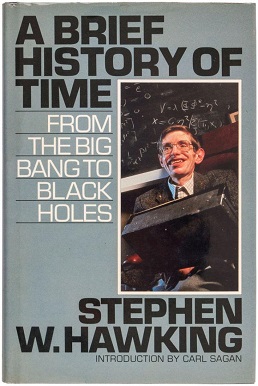
A Brief History of Time: From the Big Bang to Black Holes is a book on theoretical cosmology by English physicist Stephen Hawking. It was first published in 1988. Hawking wrote the book for readers who had no prior knowledge of physics.
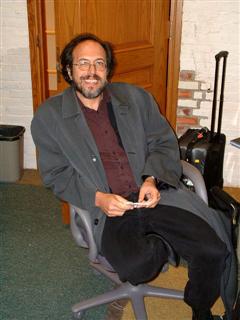
Lee Smolin is an American theoretical physicist, a faculty member at the Perimeter Institute for Theoretical Physics, an adjunct professor of physics at the University of Waterloo and a member of the graduate faculty of the philosophy department at the University of Toronto. Smolin's 2006 book The Trouble with Physics criticized string theory as a viable scientific theory. He has made contributions to quantum gravity theory, in particular the approach known as loop quantum gravity. He advocates that the two primary approaches to quantum gravity, loop quantum gravity and string theory, can be reconciled as different aspects of the same underlying theory. He also advocates an alternative view on space and time that he calls temporal naturalism. His research interests also include cosmology, elementary particle theory, the foundations of quantum mechanics, and theoretical biology.

Michio Kaku is an American theoretical physicist, activist, futurologist, and popular science writer. He is a professor of theoretical physics in the City College of New York and CUNY Graduate Center. Kaku is the author of several books about physics and related topics and has made frequent appearances on radio, television, and film. He is also a regular contributor to his own blog, as well as other popular media outlets. For his efforts to bridge science and science fiction, he is a 2021 Sir Arthur Clarke Lifetime Achievement Awardee.
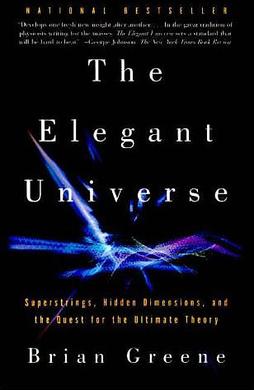
The Elegant Universe: Superstrings, Hidden Dimensions, and the Quest for the Ultimate Theory is a book by Brian Greene published in 1999, which introduces string and superstring theory, and provides a comprehensive though non-technical assessment of the theory and some of its shortcomings. In 2000, it won the Royal Society Prize for Science Books and was a finalist for the Pulitzer Prize for General Non-Fiction. A new edition was released in 2003, with an updated preface.
Since the 19th century, some physicists, notably Albert Einstein, have attempted to develop a single theoretical framework that can account for all the fundamental forces of nature – a unified field theory. Classical unified field theories are attempts to create a unified field theory based on classical physics. In particular, unification of gravitation and electromagnetism was actively pursued by several physicists and mathematicians in the years between the two World Wars. This work spurred the purely mathematical development of differential geometry.
Fuzzball theory, which is derived from superstring theory, is advanced by its proponents as a description of black holes that harmonizes quantum mechanics and Albert Einstein's general theory of relativity, which have long been incompatible. Fuzzball theory dispenses with the singularity at the heart of a black hole by positing that the entire region within the black hole's event horizon is actually an extended object: a ball of strings, which are advanced as the ultimate building blocks of matter and light. Under string theory, strings are bundles of energy vibrating in complex ways in both the three physical dimensions of space as well as in compact directions—extra dimensions interwoven in the quantum foam.
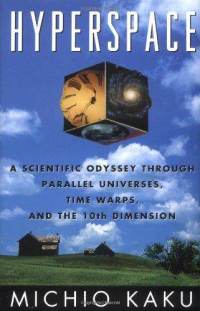
Hyperspace: A Scientific Odyssey Through Parallel Universes, Time Warps, and the 10th Dimension is a book by Michio Kaku, a theoretical physicist from the City College of New York. It focuses on Kaku's studies of higher dimensions referred to as hyperspace. The recurring theme of the book is that all four forces of the universe become more coherent and their description simpler in higher dimensions.
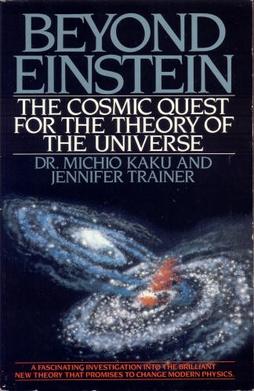
Beyond Einstein: The Cosmic Quest for the Theory of the Universe is a book by Michio Kaku, a theoretical physicist from the City College of New York, and Jennifer Trainer Thompson. It focuses on the development of superstring theory, which might become the unified field theory of the strong force, the weak force, electromagnetism and gravity. The book was initially published on February 1, 1987, by Bantam Books.

Parallel Worlds: A Journey Through Creation, Higher Dimensions, and the Future of the Cosmos is a popular science book by Michio Kaku first published in 2004.
In non-technical terms, M-theory presents an idea about the basic substance of the universe. As of 2023, science has produced no experimental evidence to support the conclusion that M-theory is a description of the real world. Although a complete mathematical formulation of M-theory is not known, the general approach is the leading contender for a universal "Theory of Everything" that unifies gravity with other forces such as electromagnetism. M-theory aims to unify quantum mechanics with general relativity's gravitational force in a mathematically consistent way. In comparison, other theories such as loop quantum gravity are considered by physicists and researchers/students to be less elegant, because they posit gravity to be completely different from forces such as the electromagnetic force.
In particle physics and physical cosmology, Planck units are a set of units of measurement defined exclusively in terms of four universal physical constants, in such a manner that these physical constants take on the numerical value of 1 when expressed in terms of these units. Originally proposed in 1899 by German physicist Max Planck, these units are a system of natural units because their definition is based on properties of nature, more specifically the properties of free space, rather than a choice of prototype object. They are relevant in research on unified theories such as quantum gravity.

The Future of the Mind: The Scientific Quest to Understand, Enhance, and Empower the Mind is a popular science book by the futurist and physicist Michio Kaku. The book was initially published on February 25, 2014 by Doubleday.

James Edward Baggott is a British science writer living in Reading, Berkshire, England who writes about science, philosophy and science history. Baggott is the author of nine books, including Farewell to Reality: How Modern Physics Has Betrayed the Search for Scientific Truth, Origins: The Scientific Story of Creation, Higgs: The Invention and Discovery of the God Particle and The Quantum Story: A History in 40 moments.

The Future of Humanity: Terraforming Mars, Interstellar Travel, Immortality, and Our Destiny Beyond Earth is a popular science book by the futurist and physicist Michio Kaku. The book was initially published on February 20, 2018 by Doubleday. The book was on The New York Times Best Seller list for four weeks.











